
gA new sensation in business card filingh eharrytoreefby Hiyoshi
Packing Corporation, 714 Yen
There are a number of methods available for filing paper.
For example, such things as making holes in the paper and binding it with
something like a ring or fastening it in a binder.
Furthermore, there is also the method of putting it into a clear folder or
pocket.
Amidst these methods, this takes a completely different approach.
What it uses is glue.
Using glue will certainly bind the papers; however, after they are bound it
wonft be possible to retrieve the papers again.
The term filing implies that simultaneously with a document being bound, it
is imperative that it can be retrieved at any time.
The product this time, even while filing with glue, allows for easy retrieval.
The productfs name is eharrytoreef.
In Japanese, eharif means stick and etorifmeans take and the features of
this product have, without elaboration, become the brand name.
The size is in the region of being slightly larger than a business card and
just about exactly the size of a business card holder.
The filefs thickness, which represents its capacity, is about just on 1.5cm
and, for this size it is quite something.
The cover is made of PP.
The exterior is black but on the inside it has been given a colour scheme with
vivid colours including green, orange and blue etc.
The impression is of a one level greater intensity of the brightness of the
colourful band on the Moleskine package.
With the Moleskine, when you go to use it as a notebook you take the band off
but, with this harrytoree, you can enjoy the colour scheme the whole time.
Three types of methods for opening the front cover are available.
The three fastening methods are a rubber band fastener type, a tab passing
through a loop closure type and a type that is fixed by a cut out trapezium
shape that protrudes just a little.
Personally, it is the last type that I like.
This is because with this it can be opened and closed with one hand.
When opening it just putting a finger on the trapezium shape fastener and
slightly expanding it is all it takes.
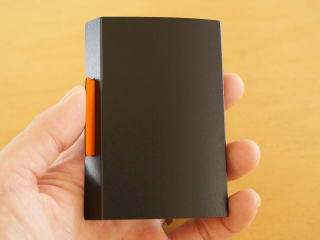
Also, when closing it, just by simply pushing both sides together with one hand
it can be snapped shut.
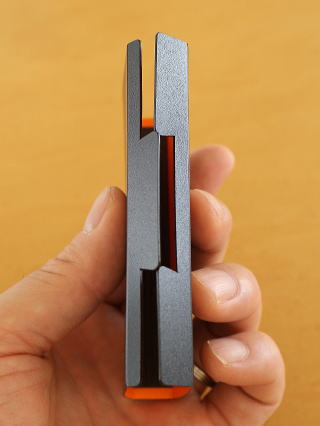
So then, as this eharrytoreefsfmost important feature, letfs look at the
adhesive filing.
Open the front cover and, inside the spine, a strip of black sticker-like
material is pasted in.
If you hold it close and look very, very carefully this is cut into six equal
lengthways strips.
By peeling off the surface of one of those strips, like the way you use a sticker,
the adhesive surface is revealed.
It is to this adhesive surface that business cards are stuck in.
Even saying they are stuck in, the adhesive surface is no more than a bit over
1 millimetre in width.
In a space with such a narrow width, how is it possible to stick in a business
card?
It is the thin horizontal edge of the card, perhaps we can call it the business
cardfs cut end that gets stuck in.
The thickness of a business card is from about 0.1 to 0.2 millimetres.
Can such a thin surface really be stuck in?
Letfs actually try sticking it and see.
Looking back over my entire life up until now, I have always stuck down the
surface of a piece of paper; so, sticking paper by its edge is an extremely
novel feeling.
Timidly sticking it in to see what happens, it sticks much more firmly than
I had expected.
If you try to stick in a business card you will notice, but the adhesive surface
has, to just a tiny degree, a sponge like elasticity.
With a business card stuck in, even if the eharrytoreef is turned upside down
the card wonft fall out.
Even if the business card is pinched and shaken a little it remains fixed.
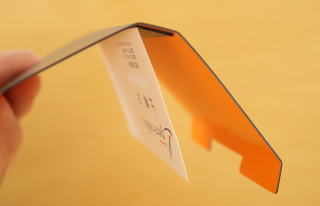
Moreover, even if lightly pulled the impression is that it is quite sturdily
fixed.
This is fun.
When sticking in the first card, because it is necessary to line it up with
the extreme edge of the adhesive surface without any guiding reference, a little
care is required.
However, from the second card onwards, it is possible to align the card with
the one immediately next to it, making it comparatively easy.
While it also depends on the thickness of the business cards, on one of these
adhesive surfaces it is claimed that six or seven business cards can be adhered.
In a trial with my business cards, the number was six.
This is to say, as there are six strips, a maximum of just under 40 business
cards can be affixed.
What is unique about this is that when they are stuck in like this, the business
cards can be flicked through and perused just like leafing through the pages
of a book.
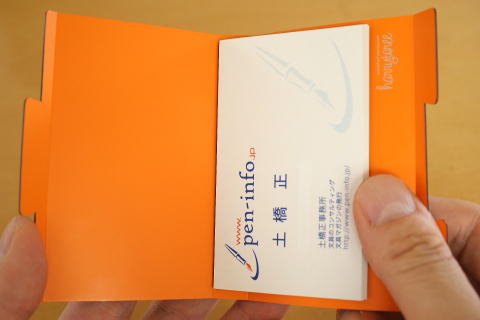
Actually no, this is different to the feeling of leafing through a book.
This is much easier to leaf through than the average book.
In comparison it is more like a notebook designed to enable superior page
turning.
Business cards are made from a stiff, heavy card so the actual feeling when
leafing through seems to surpass that of even such notebooks.
From the base hinge of the binding you can swing them, just like opening a door,
and flip through them.
In charge of this satisfying page turning sensation is, I think, to a large
extent the large effect that seems to come from a cushioning sponge on the
adhesive surface.
Due to this cushioning, each business card, sheet by sheet, is seemingly capable
of moving with flexibility.
So, thus far we have looked at the gharryh or gstickinghpart of the
gharrytoreeh
From here, wefll look at the gtoreeh or gremovalh.
Yes, as stated at the outset, the affixed business cards can be removed.
How this is done doesnft require a lot of difficult thought, simply peeling
them off is all that is needed.
Still, at this point the one thing to be careful of is that, just like when
peeling off a sticker, you take one side and, little by little, bend it up and
peel it off.
If done this way the card can be peeled away neatly.
Incidentally, ripping it out in one go isnft a good thing to do apparently.
Incredibly, the peeled off card can be stuck in again.
Of course itfs not only the peeled off card, a new business card can be stuck
into that spot, too.
This pasting and peeling can, according to the maker Hiyoshi Packing
Corporation, depending on the quality and thickness of the paper, be used for
approximately a possible 100 repeats.
With this unique functionality, use the eharrytoreef and business card
management is, I expect, sure to be done in this kind of way:
@
@In advance keep approximately 30 of your own business cards stuck into the
eharrytoreef,
@
then, when exchanging business cards with someone, pull out the eharrytoreef
and with a little ripping noise (this is a little like the sound it makes) peel
out and proffer your own card.
As for the received business card of the other party, for the time being use
the eharrytoreef like a business card case and just leave the card on top
of it. When the conversation has finished, stick it to the adhesive surface
which has been revealed previously when your own card was removed.
Possibly, because at this point in time you were hurrying, the card may be a
little bent but this is of no concern and it can be put in as a temporary measure.
Attaching and removing can be done easily so, for example, when returning home
on the train it can be fixed by once again sticking it in neatly.
A ripping sound as you peel your business card out and hand it over may,
obviously, be somewhat unsuitable in a business setting, so the idea might be
to designate it for the use of your personal, rather than business, cards.
Alternatively, there may be another way of using it.
This is dedicating it exclusively to business card filing.
Without putting any of your own business cards in it, use it for filing the
business cards that you receive.
For example, the business cards of all the people concerned with a project
currently being undertaken can be managed with this.
As the cards can be perused by flicking through them the necessary business
card can be found instantly.
In this way it can probably be used even in a business setting.
Or, it may be perfect for filing the business cards collected through the job
searching activities of graduating students.
To try it out I tried sticking business cards to every adhesive surface.
Unlike the general business card holder it doesnft even have a pocket.
As it is just an external cover within which business cards are nothing more
than simply stacked, a large number of business cards can be carried around
compactly.
Even with so many business cards stuck in, of course its card-holding capability
is fine.
Moreover, in addition to filing business cards, this is also highly useable
as a memo type reminder tool.
Instead of business cards, business-card-size index cards can be put in.
Initially stick in blank index cards and steadily record notes on them as you
go.
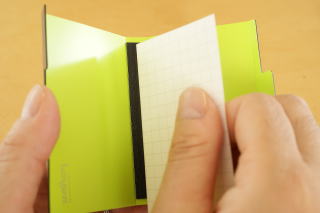
Being an adhesive system, replenishing the paper can be done easily.
Basically, it can effectively be used just like a ringless personal organiser.
Incidentally, normal notebook paper like that of a Rhodia, is too thin and
wonft stick in.
Thickness of an extent that is around that of a business card, is needed.
Index cards have paper with a degree of thickness and are conveniently available
in a business card size so are well suited for using together with the
eharrytoreef.
Maybe using it both a business card file and memo tool might work well.
By the way, as for a pen that can be attached to this, the pen previously
introduced as an emergency pen for a wallet, the Zebra SL-F1 Mini, is the best.
@When attached to the cover the nib doesnft protrude at all.
The new sensation of sticking paper by its edge is the eharrytoreef.
It looks like the range of its applications is sure to expand beyond this.
* harrytoree Official Site
![]() Top @@
Top @@![]() Other Columns
Other Columns
![]()
Copyright (C)@QOOR Tadashi TsuchihashiCAll rights reserved.